mobile View, to the German Version tap the flag


• Pisa
• Amalfi
• Kingdom of Naples
• Roman Republic
• Parthenopean Republic
• Transpadane Republic
• Cispadane Republic
• Cisalpine Republic
• Italian Republic
• Kingdom of Italy
• Elba Island
• Trieste
• Istria
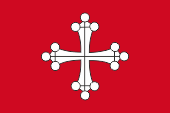
Flag of Pisa Town,
Source, by: Wikipedia (FR)





Pisa was originally a Greek settlement and was one of the 12 federal cities of Etruria. The city was a Roman colony since 180 A.D. At the time of its flowering (from the 11th to the 13th century), the Republic of Pisa was one of the most important port cities of the region (Amalfi, Genoa, Pisa and Venice). In 1399 Pisa came to the Duchy of Milan (under the Visconti), and in 1406 it came by purchase to the Duchy of Florence.
Source: Discovery '97

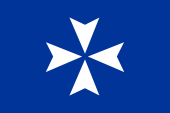
Flag of Amalfi Town,
Source, by: Wikipedia (EN)



Amalfi was from the 9th century independent, quasi a republic. At the time of its flowering (from the 10th to the 11th century), the Republic of Amalfi was one of the most important port cities in the region (Amalfi, Pisa, Genoa and Venice), who came to power and bloom by trade. In 1073 Amalfi was conquered by the Normans and lost its importance. In the years 1135 and 1137 the city was attacked from Pisa, became relatively quickly meaningless, and ultimately even dependent from Pisa. In 1582 Amalfi came to the Kingdom of Naples.
Source: Wikipedia (D)

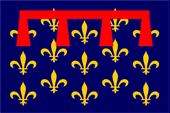
Flag of the Kingdom of Naples under the House of Anjou,
Source, by: Heraldique Europeenne



The Kingdom of Naples came into being in 1282 by the "Sicilian Vespers", a uprising which detaches the island of Sicily from the Kingdom of Sicily and let it came as a separate kingdom of the House of Aragón. The remaining Kingdom of Sicily (unofficially called as Kingdom of Naples, or Naples-Sicily) remained to 1442 at the House of Anjou.
Source: Discovery '97

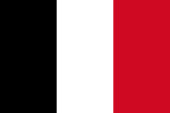
1798-1799,
Flag of the Roman Republic,
Source, by: Wikipedia (D)



The Roman Republic was created in 1798 as a French satellite state of Napoleon's grace, when French revolutionary troops marched into Rome and abolished the Papal States. It included Latium and Umbria. The French troops withdrewed in 1799, then marched into Rome troops of the Kingdom of Naples. That was the end of the Roman Republic. In 1808 this territory was directly annexed from France. After Napoleon's defeat the Papal States became restored in 1815.
Source: Meyers Konversationslexikon, Volker Preuß

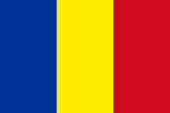
Flag of the Parthenopean Republic,
Source, by: Flags of the World



The Parthenopean Republic was created as a French satellite state of Napoleon's grace in January 1799, when French revolutionary troops occupied the Kingdom of Naples and the monarchy collapsed. Because the enemies of Napoléon invaded the north of Italy, the French troops were forced to leave the Republic Parthenopean very quickly. Already in June 1799 a popular uprising under the leadership of Cardinal Fabrizio Ruffo finished these so-called Republic, and the king out of the House of Bourbon became reinstated. The state was named after Parthenope, one of the sirens in the Greek mythology. When she died, she was washed ashore on a small island vis-a-vis of what is now Naples. Parthenope was therefore worshiped in Naples as the city goddess.
Source: Meyers Konversationslexikon, Volker Preuß

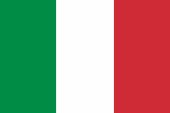
1796–1797,
Flag of the Transpadane Republic,
Source, by: Flags of the World





The Transpadane Republic was created as a French satellite state of Napoleon's grace in November 1796, after the invasion of the French revolutionary troops in northern Italy. The republic consisted roughly of the former Austrian Lombardy (Duchies of Milan and Mantua). In February 1797 Bologna and Ferrara joined the Transpadane Republic. When the Transpadane Republic was converted to the Cisalpine Republic in June 1797, the rest of the Cispadane Republic joined to that state.
Source: Wikipedia (D)

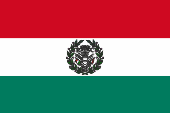
1796–1797,
Flag of the Cispadane Republic,
Source, by: Flags of the World



The Cispadane Republic was created as a French satellite state of Napoleon's grace in 1796, after the invasion of the French revolutionary troops in northern Italy. The republic consisted roughly of the Duchy of Modena, and Bologna and Ferrara (northern Romagna). In February 1797 Bologna and Ferrara joined the Transpadane Republic. When the Transpadane Republic was converted to the Cisalpine Republic in June 1797, the rest of the Cispadane Republic joined to that State.
Source: Wikipedia (D)

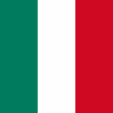
1797–1802,
Flag of the Cisalpine Republic,
Source, by: Flags of the World



The Cisalpine Republic was created as a French satellite state of Napoleon's grace in 1797, after major victories against Austria in northern Italy. So the Cispadane Republic and the Transpadane Republic were merged to the Cisalpine Rebublic. In 1802, the state was renamed to Italian Republic and became converted to the Kingdom of Italy in 1805.
Source: Wikipedia (D)

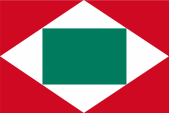
1802–1805,
Flag of the Italian Republic,
Source, by: Flags of the World



The Italian Republic was created as a French satellite state of Napoleon's grace in 1802, by renaming of the Cisalpine Republic. In 1805 the state was converted to the Kingdom of Italy.
Source: Wikipedia (D)

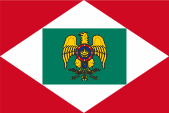
1805–1814,
Flag of the Kingdom of Italy,
Source, by: Von
Sodacan
Diese
Vektorgrafik wurde mit
Inkscape erstellt. - Eigenes Werk,
CC BY-SA 3.0,
Link



The Kingdom of Italy is not to deal with the today's Italy, which was founded not until 1861. That Kingdom of Italy was established as a French satellite state of Napoleon's grace in 1805, by transformation of the Italian Republic in precisely this kingdom, of course, with Napoleon himself as king.
Source: Meyers Konversationslexikon,
Volker Preuß,
Jürgen Kaltschmitt

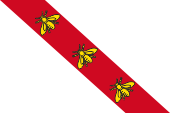
Flag of Elba Island,
Source, by: Flags of the World, Dank an Felix Hohenstein



The Island of Elba (Italian: Ìsola d'Elba) is an Italian island in the Mediterranean Sea between Corsica and Italy. It covers an area of 86 sq.mi., and in 1997 the population was 27.300 inhabitants. The island is mountainous (Capanne Mountain 1019 meters) and has a torn coast. Economy: iron ore, olives, vineyards and orchards, tourism. Capital is Portoferraio. Elba was from 1814 to 1815 the residence of Napoléon I. The flag shows three golden bees in a red diagonal stripe. The honey bee was the personal emblem of Napoleon Bonaparte, so to speak the animal emblem of the person N. Bonaparte, the eagle was the official armor of the emperor in (West-)Roman, Franconian tradition. The award of golden bees for inclusion into coats of arms was a special form of honoring by Napoléon for meritorious persons, countries or cities, like the island of Elba.
Source: Discovery '97,
Jürgen Kaltschmitt,
nearbees.de

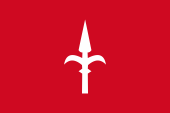
Flag of Trieste,
Source, by: Wikipedia (D)



more Info? click here → Trieste

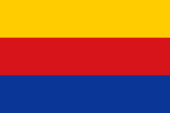
Flag of Istria,
Source, by: Wikipedia (D)



more Info? click here → Istria

Historical States in Italy, ca. 1850–1858:
all state denominations in English
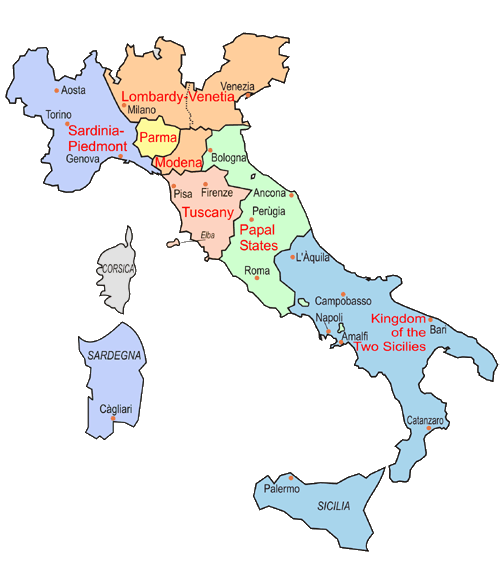
Source: Volker Preuß

Today's Regions of Italy:
all denominations in Italian
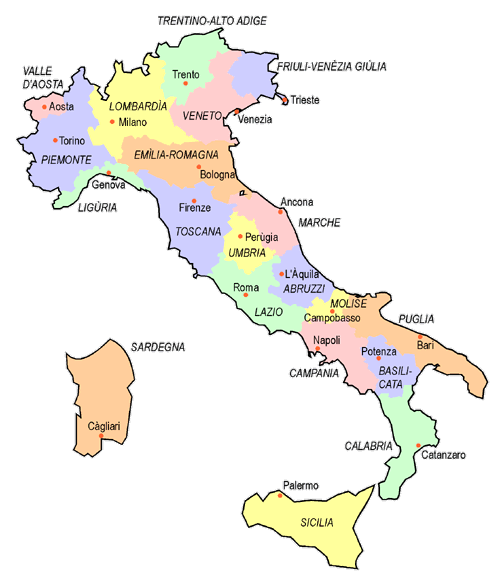
Source: Volker Preuß


Kindly supported by:

![]()












































